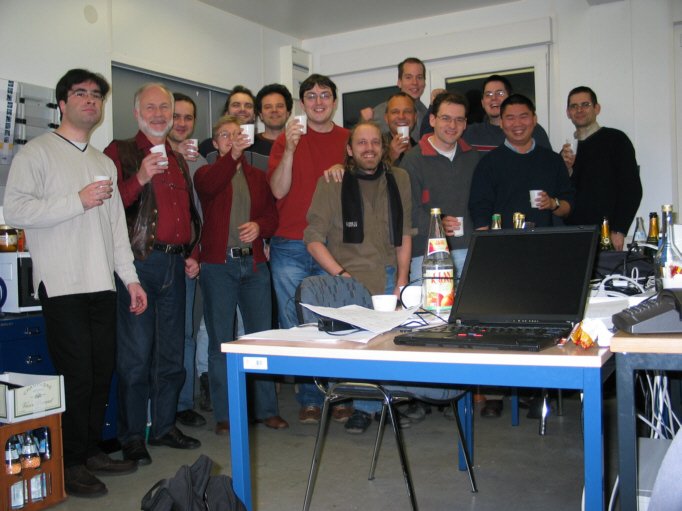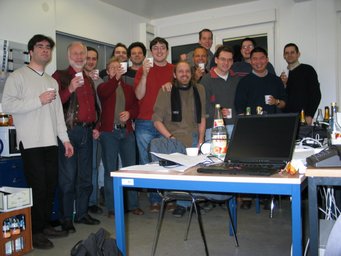2003
Two science runs
Since S1 (April 2003)

GEO's successful first Science Run (S1) had been performed without signal recycling and without the final optics. So the next aim was to exchange the test optics and to implement signal recycling. The installation of the signal recycling mirror (T = 1 %) took place in October. November was spent to lock both recycling cavities. The SR cavity remained in lock not longer than 2 min. It became obvious that the radii of curvature of the endmirrors do not match our demands. So it was very difficult to obtain a stable lock.
After installation of the beamsplitter and the endmirrors MNC and MCE with monolithic suspensions in December, work on dual recycling lock continued. In January and February 2003, we tried to change the radii of curvature of the mirrors by means of adaptive optics. A ring-shaped heater behind the mirror produces a temperature gradient ensuring the correction of the curvature. With this measure we obtain a near perfect dark fringe and now continue work on signal recycling.
Because of these problems we were not able to take part in the second Science Run (S2 during March and April 2003). At the time being, we try hard to obtain again long-time stable performance. Our aim is to take part in the third Science Run as the first detector with dual recycling and completely monolithic suspensions.
November 2003
Signal recycling has been installed successfully in GEO600. After some very busy weeks with more or less stepweise improvements, dual recycling is working with a long-term stability close to that for the power recycled Michelson. As concerns the sensitivity we are confident that we match our goals, so that we will participate in the third Science Run.
S3: October 31, 2003 - January 5, 2004
Winter 2003
December
GEO joined LIGO for the first week of S3 with moderate sensitivity. In the following weeks the GEO team worked hard to further improve the interferometer and to eliminate several sources of noise. They managed to increase the peak sensitivity at 1 kHz by a factor of ten. So, toward the end of the S3 run GEO600 achieved a sensitivity close to that of LIGO and joined again on Dec 30. The LIGO team used this opportunity to extend S3 by four additional days in order to increase the overlap period. Thus the S3 run ended on Jan 9. GEO600 achieved a duty cycle of 98.6 %; the longest uninterrupted run lasted for 95 hours.
